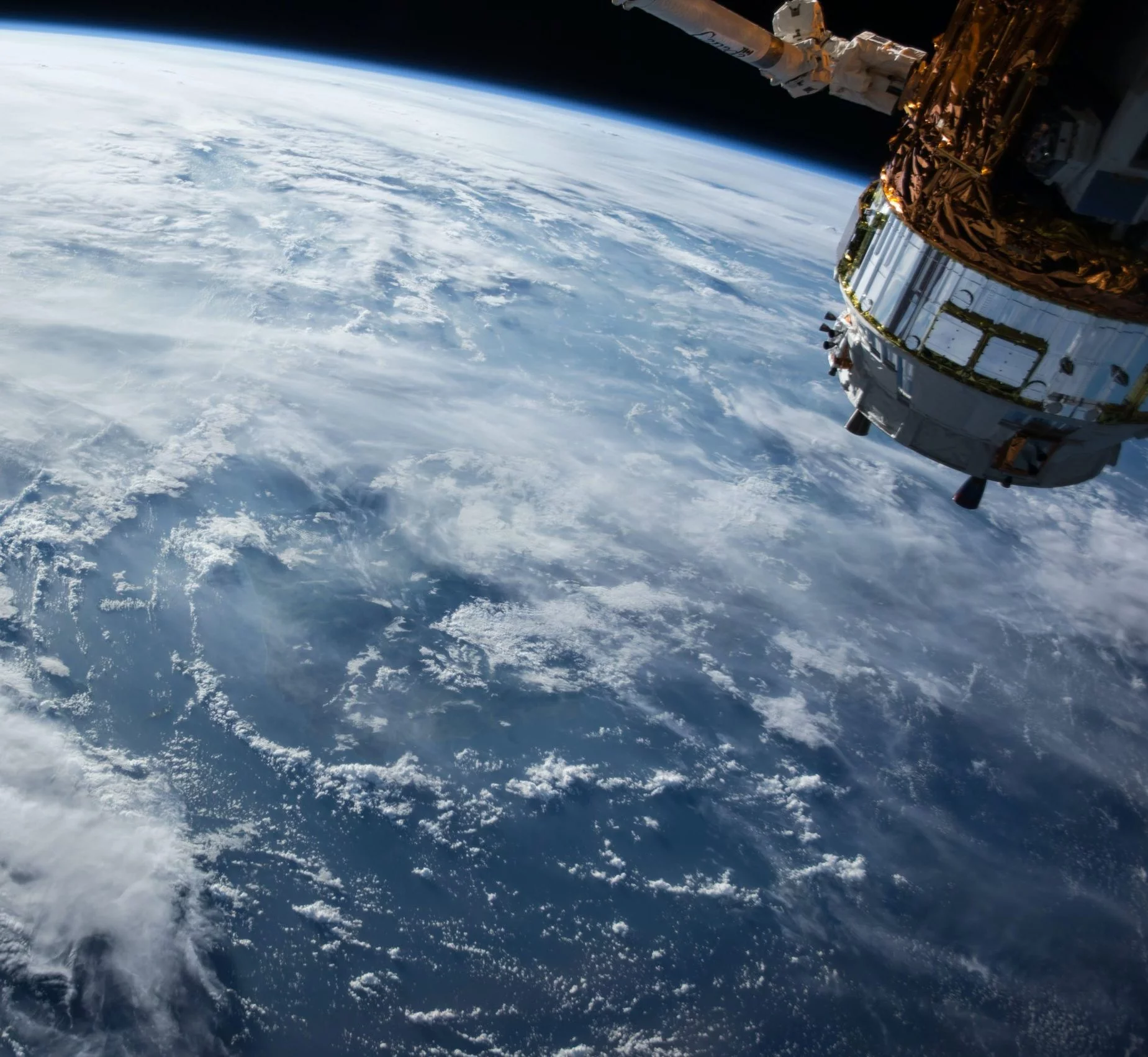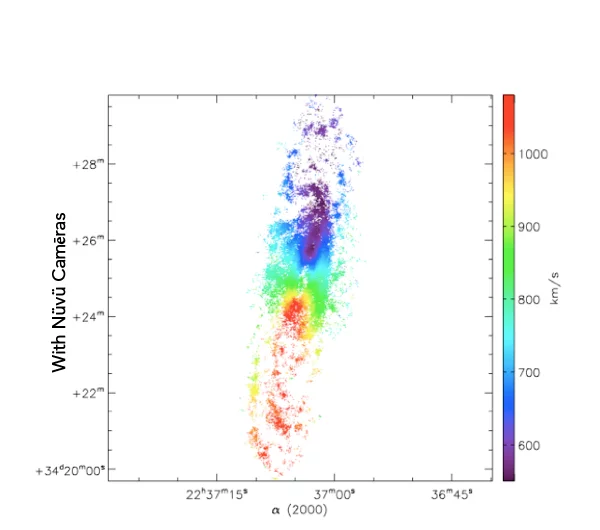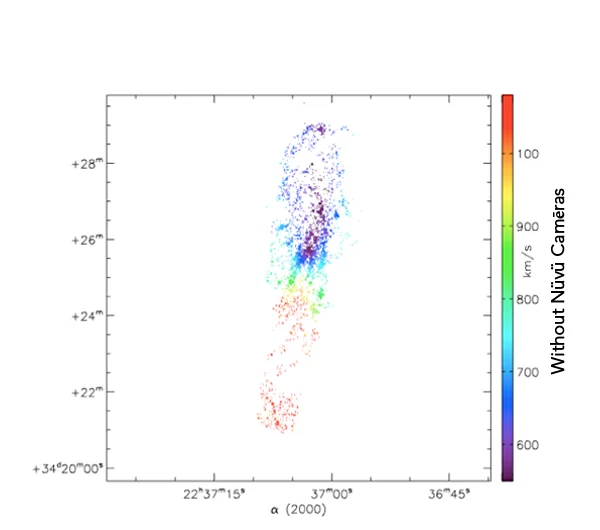Products
Your all-inclusive solution
All Products
Download our catalog
Get our Catalog
Applications
The colossal potential of our technology is starting to emerge and yet needs to be fully grasped. The following EMCCD ground and space-based applications are only the tips of the iceberg.

With the increase of launches, a strong density of spatial debris has accumulated in orbit. In order to protect Earth-orbiting infrastructures, such as telecommunications satellites, there is a growing demand for the monitoring of such debris.
Furthermore, at times at the borders of our solar system, the orbits of certain asteroids and comets can cross that of Earth. These objects, also known as Near Earth-Objects (NEO), will threaten life as we know it if they ever come in collision with our planet. The identification of such objects, with a diameter greater than 100 meters and with the potential to hit Earth, is therefore vitally important.
All spatial debris that is more than one centimeter constitutes a threat to devices in orbit around our planet and requires great sensitivity in order to be detected. In addition, an imaging device must distinguish these objects from other sources of noise like cosmic rays that can affect areas of development. In the same manner, NEOs are objects with very little luminosity that require an excellent level of sensitivity from detectors to determine trajectories.
With the CCCP, a patented technology that reduces clock induced charges, Nüvü Camēras are conceived for the precise imaging in low light environments. To this day, the sensitivity of these cameras cannot be matched. Furthermore, Nüvü Camēras’ products have greater quantum efficiency and faster acquisition speeds that lead to short integration times, thus limiting the impacts of cosmic rays on the quality of captured images.
R.L Scott (Research and Development for Research Canada) and A. Ellery (Carlton University) have studied ground-based surveillance of geostationary on-orbit servicing operations – therefore capable of reducing spatial debris- with an EMCCD EM N2 1024 camera from Nüvü, mounted to the 1.6m telescope at Mont-Megantic Observatory. They have demonstrated the potential satellite surveillance from the ground for future servicing missions.
Peter Brown and his team from the University of Western Ontario have a substantial body of work in meteor physics. One of their interests is the observation of the Kuiper belt, most notably to characterize the distribution of small, typically undetectable kilometer-sized objects through stellar occultation. By using Nüvü’s HNü 1024 EMCCDs, they have successfully conducted their observations and validated their methods, paving the way for a dedicated telescope array and many future measurements of Kuiper belt objects.
The surveillance of coastal phenomenon is essential for a number of government agencies: for example, it provides important information on fish populations, maritime transit routes, and even allows for the prediction of climate behaviors in the region. Such data, acquired through the surveillance of oceanic water columns, can reduce the risks of maritime navigation, explorations of the sea, and coastal settlements.
Costal surveillance requires imaging systems that operate in the visible and near-infrared wavelengths, but such devices have a limited quantum efficiency in this specter. Additionally, only 20% of the light emitted by the oceans can be detected due to the atmospheric diffusion as well as the light reflection on the surface of the water. Consequently, this signal is quite weak.
Recent studies have obtained interesting results by using EMCCD detectors such as the HNü. With its remarkable sensitivity in visible and near infra-red wavelengths, as well as its performance in photon counting, Nüvü Camēras’ technology will improve the precision and the diversity of phenomenon data affecting coastal regions and the seabed.
The article The Darkest EMCCD Ever demonstrates that low EMCCD noise levels attained thanks to the patented CCCP camera controller from Nüvü™ allows for the increase in telescope efficiency and the widening of their observation scopes.
The observation of Earth from space brings a different, but fundamental, perspective towards the protection and durability of the environment. The imaging of the dark side of Earth during nighttime provides a more complete outlook on climate and environmental changes affecting human life.
Developed for imaging in low light, the EMCCD technology meets its limits in environments with near-total darkness. Indeed, in such cases, the readout noise is too large to collect accurate data. This problem is by-passed by the photon counting method, in addition to the clock induced charges, which then become the dominant source of noise.
The effects of clock induced charges on readout noise can be minimized, even eliminated, by regulating in the appropriate manner the clock induced charge of the camera controller. This is what Nüvü Camēras offers with its CCCP controller that reduces an EMCCD readout noise to less than one electron per pixel. This patented innovation allows for photon counting with the best quantum efficiency and an excellent charge transfer for accurate results even in conditions with near-total darkness.
Nearly 2000 extrasolar planets have been identified, most being Jupiter- and Neptune-class. Yet astronomers believe it is just the tip of the iceberg: recent studies predict an average of one planet per star in the Milky Way. Nevertheless, most exoplanet detections are indirect and based on star monitoring for minute luminosity changes induced by its planetary companion (see the Transient Photometry section). In the quest to uncover more Earth twins, astronomers now turn themselves to direct observation, studying their host’s light reflected onto their surface by masking the star’s brightness with a coronagraph.
Such emission is extremely weak. A Jupiter-like planet’s is about 100,000 times dimmer than its host. For Earth analogs, their brightness drops even more, being 10 billion times lesser than the nearby star. Direct exoplanet imaging or spectroscopy thus calls for a device capable of detecting the few photons emitted from the planet’ surface that reach us, and they are scarce.
Direct extrasolar planet observation requires the most sensitive sensor there is, and Nüvü Camēras’ technology is perfectly suited for such demanding application. Nüvü™’s revolutionary CCCP technology ensures the lowest clock-induced charge levels while its innovative packaging guarantees minimal dark current. The result is a camera that can detect every photon of an Earth-like planet that may support life.
Results from the Jet Propulsion Laboratory’s characterization of the EMCCD for the space mission Nancy Grace Roman Space Telescope were obtained thanks to Nüvü™’s EMCCD technology. The Nancy Grace Roman Space Telescope is a NASA observatory designed to settle essential questions as in the area of exoplanets amongst others.
Ashlee Wilkins, from the University of Maryland, shared the results of the characterization of the HNü 512 from Nüvü Caméras, obtained in collaboration with the Goddard Space Flight Center by NASA.
With a proved track record on the Nancy Grace Roman mission, Nüvü is in talks with many future observatory project teams focused on exoplanet discovery. Notably, the Large UV/Optical/IR Surveyor (LUVOIR), a next generation space telescope, and the Atacama Large Aperture Submillimeter Telescope (ATLAST) observatory.
Bernard J. Rauscher, of the NASA Goddard Space Flight Center, presented the results of the characterization of the needs of the ATLAST detector for a spatial mission.
An exoplanet modifies the luminous flow emitted by a star when it passes by it. Numerous characteristics of this star can then be deducted from the variation in luminosity during this time: atmospheric composition, size, mass, and rays.
Schematic representation of a planet’s light curve transiting in front of its star
During the exoplanet’s transit in front of its host star, the first and last moments are of paramount importance: they unveil many of the planet’s features and occur on very short time scales. Such meaningful information can be lost in the integration time necessary for a less sensitive camera to capture images of moving objects at low light levels. Likewise, for planets with short revolution periods, the light curve shape may be hard to recover and is sometimes unreliable.
CCCP, Nüvü Camēras’ EMCCD innovative controller, achieves very high speeds while multiplying the signal to obtain a much superior SNR. The inherently lower readout noise offers a tenfold increase of an optical system’s efficiency, leading to a tremendous improvement in precision, richness, and reliability of transient events’ light curves.
The air in the atmosphere drifts in foot-long pockets that get carried by wind and convective currents. Having different temperature and density, each pocket possesses its own refractive index. While moving and merging randomly, they bend light, thus affecting the original light path and degrading the incoming signal. Such turbulent motions hinder observations at a telescope theoretical resolution.
While lucky imaging overcomes atmospheric turbulences by virtually freezing random air fluctuations, adaptive optics reconstruct the light’s path through the atmosphere and adjust the telescope’s mirror shape to flatten the wavefront. The incoming light thusly reconstructed improves a telescope’s performance to its theoretical limit, but doing so calls for both camera speed and accuracy.
With up to 20 MHz readout rates, low noise and superior sensitivity, Nüvü Camēras’ technology is suited for adaptive optics systems. Its exceptional quantum efficiency across the visible and near-infrared spectra also allows good sampling of the wavefront distortion due to air pockets. Nüvü’s cameras indeed fulfill the stringent requirements set by adaptive optics to achieve the lowest wavefront error.
The team at Gemini South observatory is developing a top of the line adaptive optics system using a pyramidal wavefront sensor prototype integrating a Nüvü™ HNü240 camera for their new Gemini Planet Imager.
Daniel Hölck-Santibanez, from Durham University, presented their adaptive optics system for the 4.2m WHT telescope.
Prof. Christoph Baranec at the Institute for Astronomy of Hawaii have developed an autonomous instrument with adaptive optics capable of conducting large scale surveys.
HiCIBaS (High Contrast Imaging Balloon System) is a balloon-borne telescope whose main goal is to demonstrate the usability of high contrast imaging equipment onboard a stratospheric balloon flight. The goals of this mission were to develop and test a new type of Low-Order Wavefront Sensor, develop and test a sub-milli-arcsecond-level pointing system, gather data on and study high-altitude wavefront instabilities and errors, test optical components (DM, Coronagraph) for future high contrast imaging missions, fly the technology in space-like conditions.
Hicibas – Balloon borne mission. Image from COPL.
nüSpace is the next step of Nüvü’s work on NASA’s Roman Grace space telescope, where the first space qualified EMCCD electronics were developed. To adapt the technology to the nanosat platform, lower power, size, and budgets were required. nüSpace is the answer to this field’s need and brings the sensitivity of EMCCDs to a variety of new space-based imaging applications.
Difficult to detect on-ground due to the absorption of sound in Earth’s atmosphere, ultraviolet (UV) rays reveal to be an incredible source of information: this portion of the specter unveils notably the chemical composition of the warmest stars, as well as the characteristics of the interstellar medium of our galaxy or beyond. To maximize its use, however, the efficient detection of these energetic rays is needed.
Although CCD technology has greatly contributed to detect new sources of UV, it offers a limited performance with weak quantum efficiency and significant readout noise. These factors negatively affect the signal to noise ratio (SNR) and lead to incorrect results due to weak luminosity and acquisition speeds.
The HNü camera from Nüvü™, made with superior quality components, reaches maximum quantum efficiency with the help of current technologies. In addition, due to the electron-multiplying (EM) process, the EMCCDs reduce the inherent readout noise and consequently increase the resolution of the acquisitions. The CCCP controller from Nüvü Camēras offers performances where the SNR can be multiplied an order of magnitude. For this reason, we even envision integrating this technology in the new generation of space telescopes dedicated to the wide-field imaging of UV and the visible spectrum.
Erika T. Hamden, from the California Institute of Technology (Department of Astronomy), shared the results of an experiment conceived to observe ultra-low light emissions with the help of an EMCCD camera from Nüvü.
Astronomers resort to high-resolution spectroscopy for a broad range of applications, from redshifted galaxies to nano-flares studies. It provides very precise information on an incident photon’s energy or unfolds events happening on very short time scales.
Both spectral and temporal resolutions depend on the photon count per pixel being as low as possible. For the former, reaching high resolution means that every pixel ideally measures a unique wavelength. For the latter, high resolution implies richer sampling and a lesser chance of aliasing with short integration time. In both cases, the signal coming to the camera is very faint. Single photons need to be processed, requiring excellent SNR so they remain above the noise threshold. Time-dependent noises (like dark noise) limit high spectral resolution spectroscopy; fixed noises (like readout and CIC) hinder high temporal spectroscopy.
Nüvü Camēras’ controller produces the lowest clock-induced charges of any EMCCD on the market, thanks to its re-invented electronics. Its electron-multiplying ability and photon counting mode decreases read noise to a minimum, allowing for very high temporal resolutions. Moreover, with their resolutely low dark current, Nüvü™ thermoelectrically cooled cameras support integration times of several seconds in a high spectral resolution scheme. In fact, with Nüvü™ advanced cameras, there are virtually no disadvantages to gather high-resolution spectrums.
The Characterization results of EMCCDs for extreme low light imaging article describes how Nüvü™ cameras obtain low background signal, even at high pixel rates.
MOVIES is a broad bandwidth, moderate-resolution optical and near-infrared (NIR) échelle spectrograph that simultaneously covers 0.36 – 2.45µm. It is supported by a rapid acquisition 16MPixel EMCCD camera operating simultaneously in two optical and one NIR bands. MOVIES is designed for obtaining spectra of the faint Universe with high throughput, high efficiency, and high reliability. It is equipped with the same “go-to” long slit spectrograph for the follow-up of faint objects from future facilities such as LSST, the Nancy Grace Roman Space Telescope and DESI, and will be a valuable feeder instrument for the ELTs. MOVIES is fundamentally a time-domain spectrograph, a precision spectrophotometer, and a workhorse instrument for the Gemini community.
Information on MOVIES from Gemini website.
Imaging devices with the lowest possible readout noise are paramount for high quality observation not limited by background or shot noise. In that regard, the EMCCD’s sub-electron readout noise makes it the ideal candidate for low light imaging applications. However, due to the stochastic nature of the electron-multiplying gain that counters readout noise, EMCCDs are flawed with an Excess Noise Factor (ENF) that has the same effect on the signal-to-noise ratio as halving the camera Quantum Efficiency (QE).
To recover the acquisition system’s full capabilities, it is possible to operate in Photon Counting mode in which a signal as little as a single photon per pixel per image can be recorded. For greater dynamic range, images can be superimposed and the threshold adjusted accordingly. In this context, EMCCDs are to be used for imaging very faint light sources and/or at considerable high speeds. The latter case however produces spurious charges, also referred to as clock-induced charges (CIC), which becomes the dominant noise source in EMCCDs. With high CIC levels and insufficient electron-multiplying gain, it is futile to operate the camera in Photon Counting mode.
Nüvü Camēras’ CCCP controller (CCD Controller for Counting Photons) arises from an academic research endeavour. It was developed from the ground up with the objective of elegantly mastering the major noise source in Photon Counting applications, the CIC. The CCCP is best suited for the modern astronomer needs as it produces significantly less CIC, which allows efficient use of a higher EM gain and makes a key difference in imaging performances.
With that much less noise, there are virtually no disadvantages to take high-resolution images and post-process them in order to select the desired SNR and/or spectral resolution. In fact, this is changing the way astronomers use spectroscopy, as one can choose to bin frames temporally or spectrally to any desired extent while keeping track of the higher dynamics inside the high-resolution original images.


Any questions about EMCCD or low light imaging? Nüvü Camēras experts can provide advices on your low light imaging options.